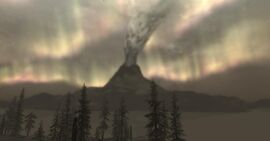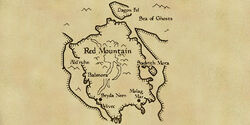
Red Mountain seen from Solstheim.
Red Mountain, also referred to as Dagoth Ur, is the large, currently active, volcano that makes up the majority of the island of Vvardenfell, in the province of Morrowind. The volcano is the largest in Tamriel, although its occasional reference to as Dagoth Ur is likely due to an error on the part of an Imperial scribe, as Dagoth Ur was the name of a Chimer general whose undead form was trapped under Red Mountain for centuries.
History
Near the end of the creation process, as many of the Aedra began their exodus from Nirn, a smaller group chose to stay and forfeit their divine existence to give life to the planet. Among these was Lorkhan, the Aedra generally credited with devising the original plan for the mortal plane. According to Aldmeri legend, the remaining Aedra were furious with what they considered Lorkhan's trickery and tried to destroy him. However, the physical manifestation of Nirn, known as the Ehlnofey or "Earth Bones," came from Lorkhan himself, and so his true destruction was impossible. Instead, his heart was torn from him and cast to Tamriel, where the Aedra hoped it would never be found. Over the place where the heart landed a vast mountain was created, which the many races of Tamriel call the Red Mountain.
During the Merethic Era, the Aldmer left their home and travelled to the Summerset Isles on Tamriel. One particular group of them, led by their prophet Veloth, chose to split from the core population, and travelled across the continent to their new home, which they named Resdayn. Once there, these Mer, now called Chimer, were somewhat surprised to see that the caves and tunnels under Red Mountain were already inhabited. These inhabitants, also Mer, called themselves the Dwemer. An uneasy peace was formed between these races, primarily motivated by their drive to keep the Nords of Skyrim out of the land.
Sometime during the early First Era, the Dwemer located Lorkhan's Heart beneath Red Mountain, and began trying to use its power to achieve godhood. The Chimer, driven by fear, attempted to stop their brethren, quicky leading to a vast war. This war eventually ended with the complete disappearance of the Dwemer, the emergence of the Dunmer, and Red Mountain first known eruption in 1E 668 in an event called Sun's Death.[1]
By at least 4E 5, Red Mountain erupted once again,[2] having nearly completely devastated all of Vvardenfell and Morrowind. Many unprecedented effects and aftershocks could be felt across Tamriel. As a result, most of the province of Morrowind remains a volcanic wasteland, forcing many of its surviving residents to migrate into the nearby provinces of Cyrodiil, Black Marsh, and to Skyrim through Dunmeth Pass.
Climate
For centuries, the mountain spat ash into the air, covering most of northern Vvardenfell, which was aptly named The Ashlands. The rocky, cavernous foothills of the mountain dominate nearly three quarters of the island. Cooled, once constant, lava flows have created deep, smooth channels that are often used as roads by the Ashlanders. The land to both the north and east of the mountain is arid and barely habitable, all the way to the Padomaic Sea.
Near the end of the Third Era, the climate around the volcano grew increasingly hostile. Violent ash storms began thundering down the mountain faces, blasting high winds and tons of ash at the nearby cities and settlements.

Map of Red Mountain.
The storms appeared to be partly magical in nature, as they would often corrupt wildlife, and even people, in their wake. These storms ended after another battle occurred in the caverns beneath the volcano. Among the most notable outcomes of this battle was that Red Mountain had reverted to, presumably, its pre-volcanic form. The area continued to be rocky and cavernous, but the ash storms and hard weather subsided.
Religious significance
Red Mountain holds different religious significance to the various factions on Morrowind.
For a brief period of time, a cult known as the Sixth House, led by a reanimated Dagoth Ur, used many of the long-abandoned Dwemer workshops beneath Red Mountain as their home. The members often spoke of the mountain as an animate object, which spoke to them in their dreams. In this sense, the mountain symbolized Dagoth Ur himself, attempting to control his subjects from within his undermountain prison.
For the Ashlanders, the mountain was viewed as a haunted place, containing the remnants of the hated Dwemer.
The Tribunal Temple taught that Red Mountain was a place of trials and great evil. The Tribunal themselves built a huge magical barrier, the Ghostfence, around the mountain to contain Dagoth Ur and his attacks on Morrowind. The Ghostfence became a religious symbol of the Tribunal itself, and was a popular pilgrimage destination.
Trivia
- The Ministry of Truth, which floated above the city of Vivec, fell from the sky, crushing the city below. It is theorised that the massive vibration caused by the impact may have been the cause of the eruption.
- Red Mountain's eruption in the Fourth Era is also believed to be related to the Great Collapse of Winterhold.
- Red Mountain can be seen from the far eastern border in The Elder Scrolls V: Skyrim. It can also be seen at the top of the Throat of the World on clear days.
- It is supposed that the Sun's Death event greatly affected the Nirnroot plant species.[1]
- In The Elder Scrolls V: Skyrim, the volcano can be seen past the borders. The borders can be passed via the console command
tfc, disabling borders in the files, or going in a city then going over the walls and travelling to it's location. - The still-erupting volcano can be seen fully in The Elder Scrolls V: Dragonborn from almost anywhere on Solstheim. The mountain can also be seen in the distance from Dayspring Canyon in Dawnguard.
Appearances
- The Elder Scrolls III: Morrowind
- The Elder Scrolls IV: Oblivion (mentioned only)
- The Infernal City
- Lord of Souls (mentioned only)
- The Elder Scrolls V: Skyrim (Seen via console commands, mentioned only)
